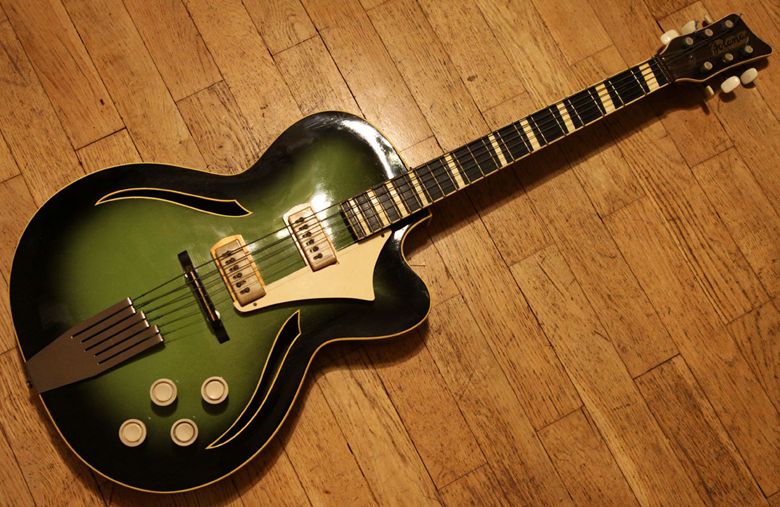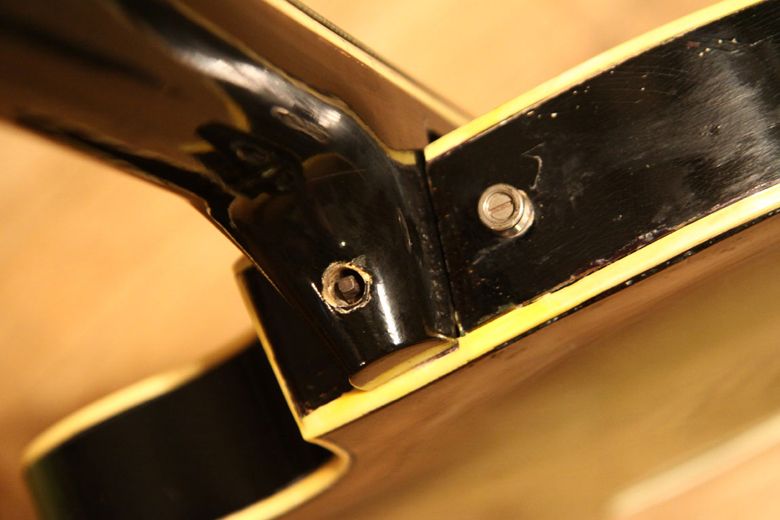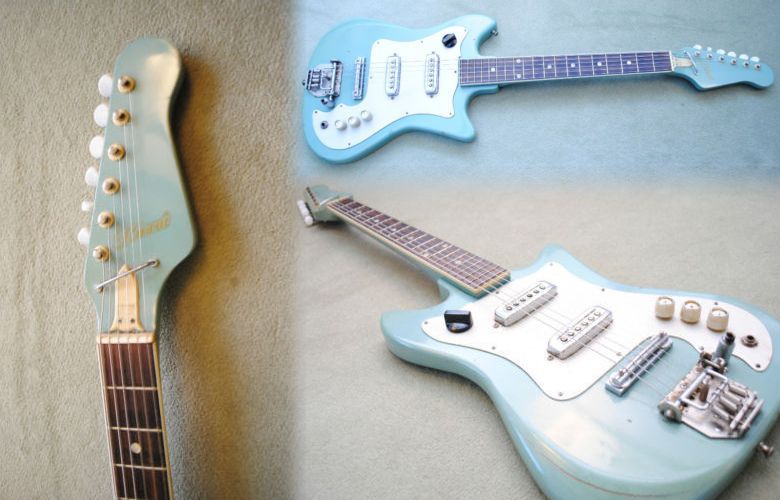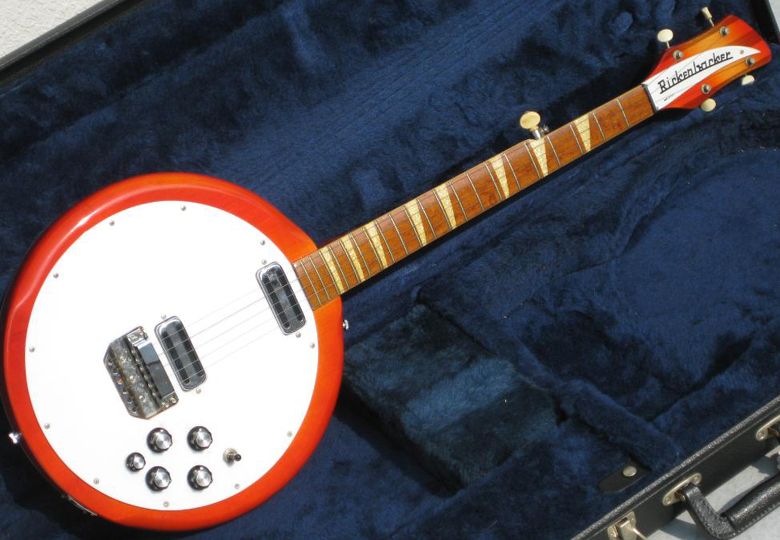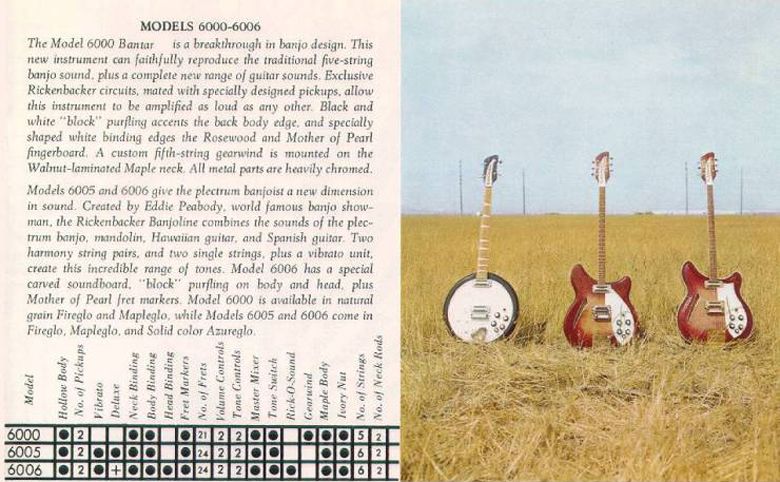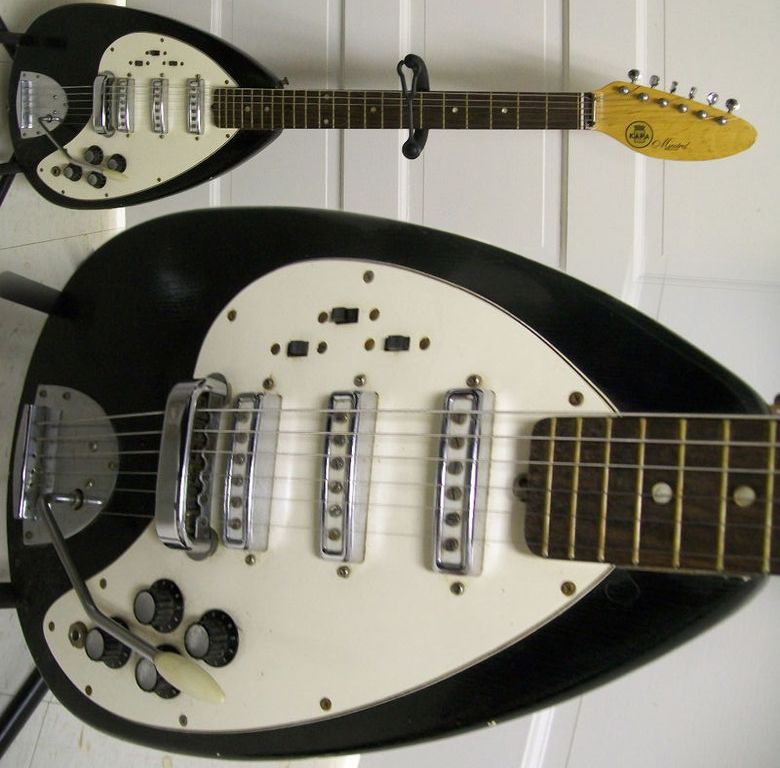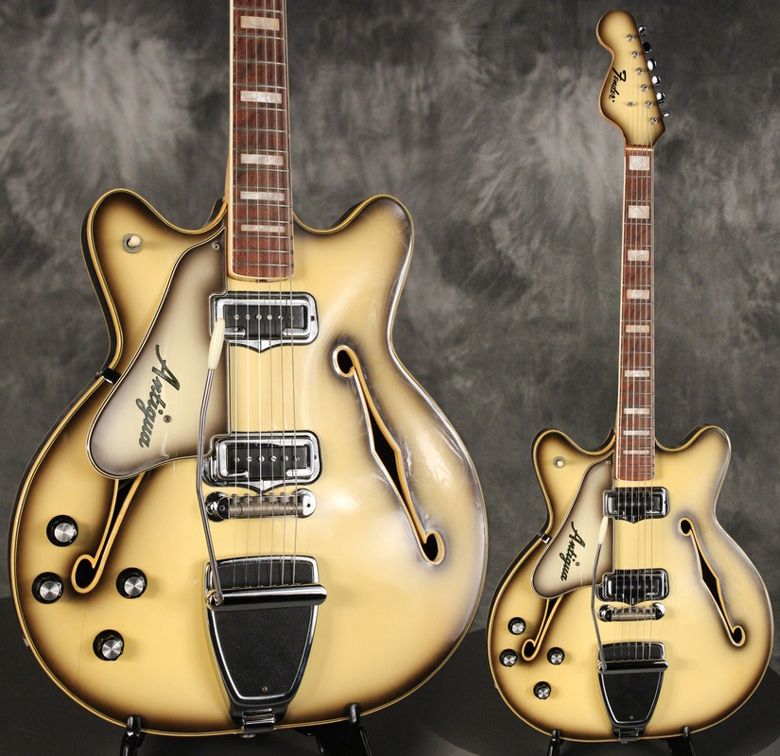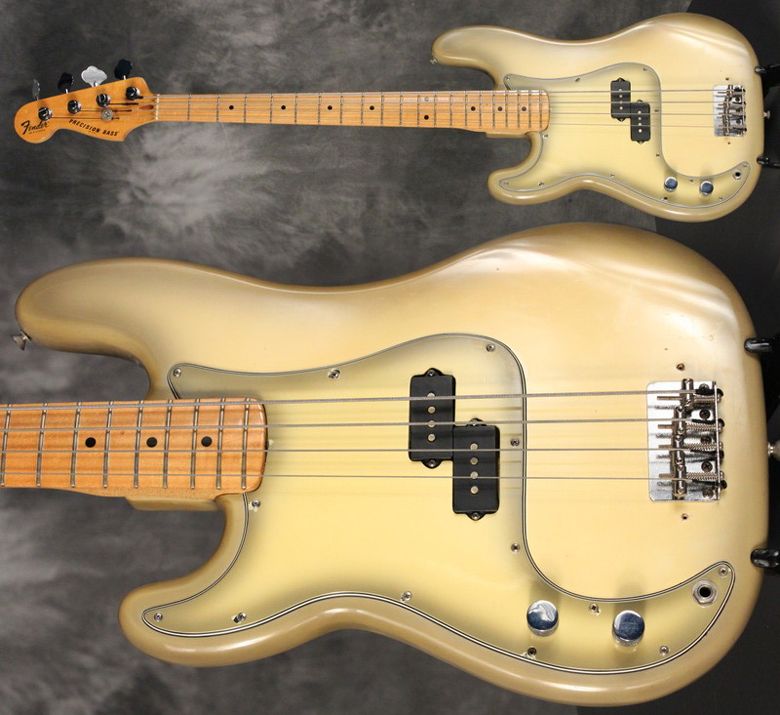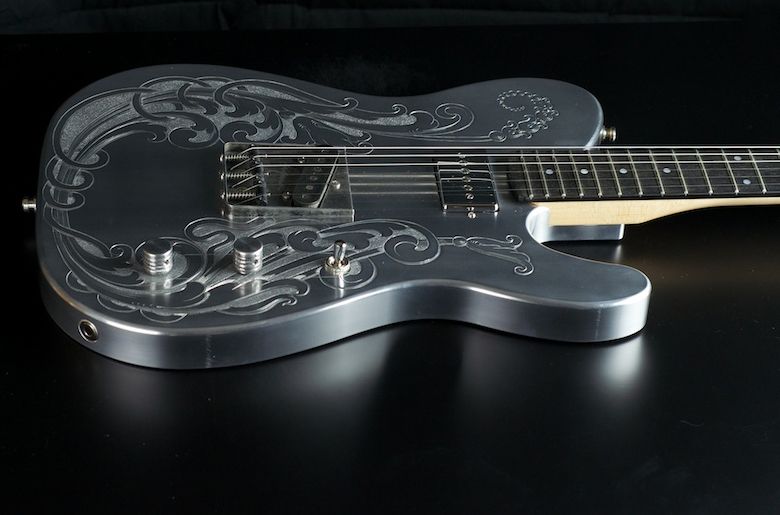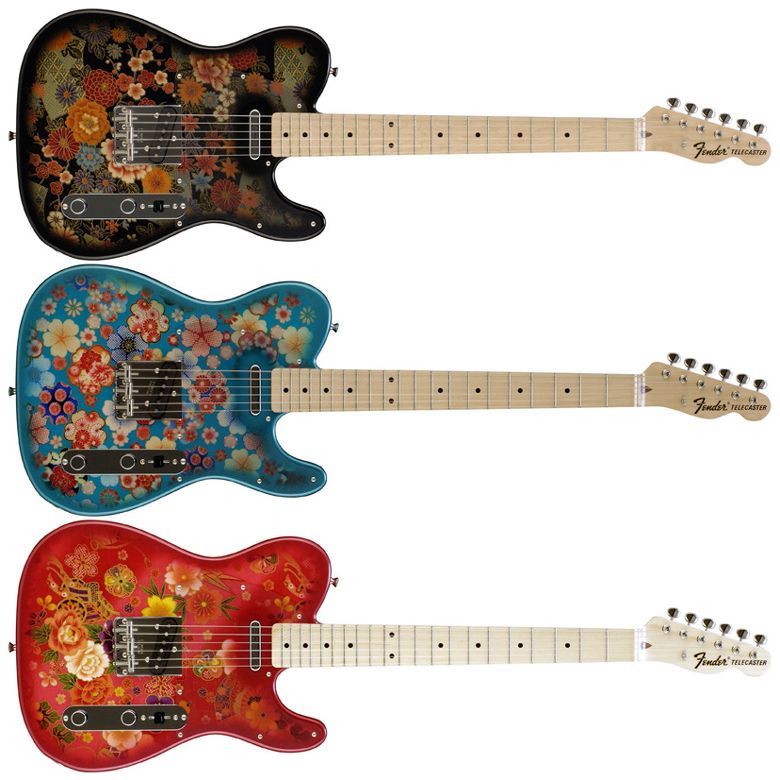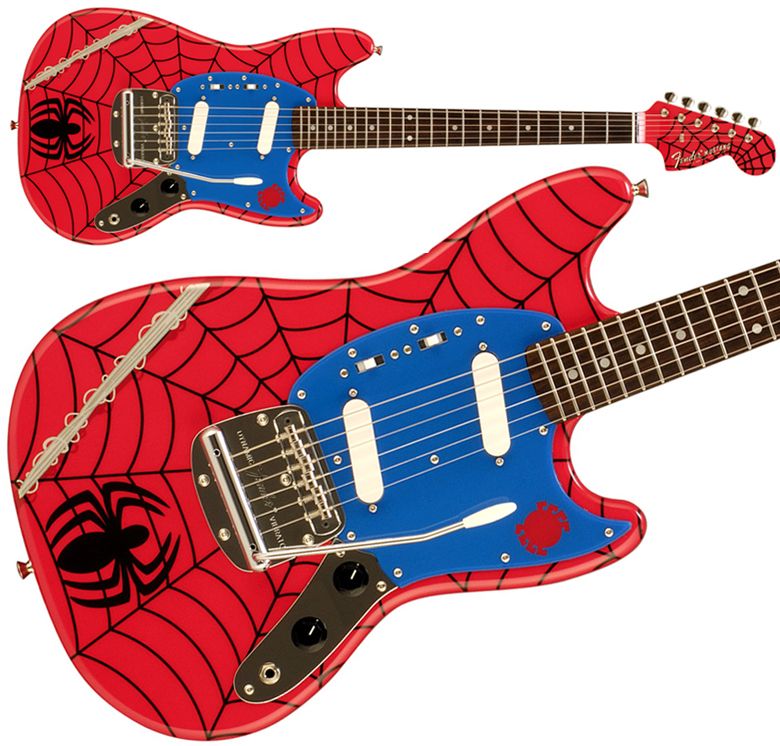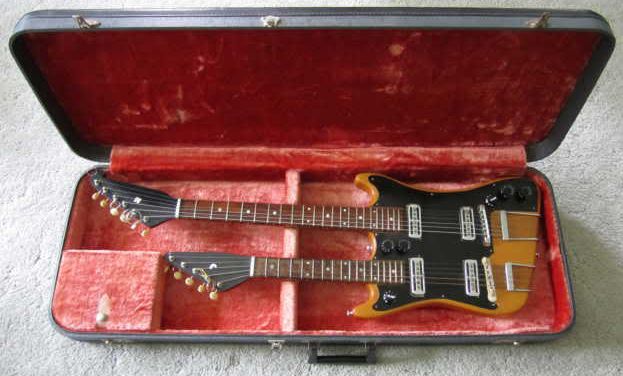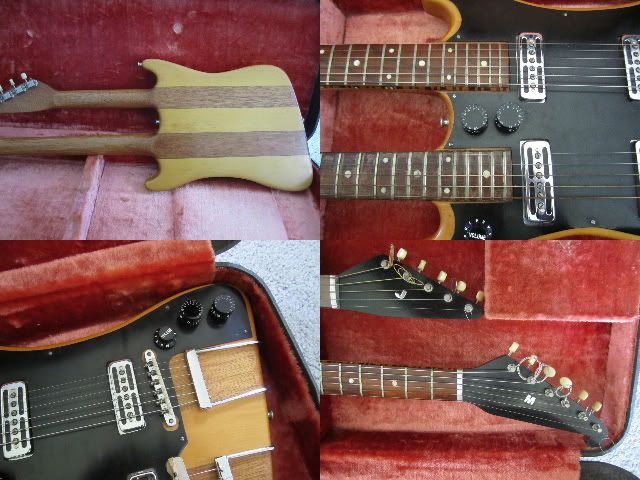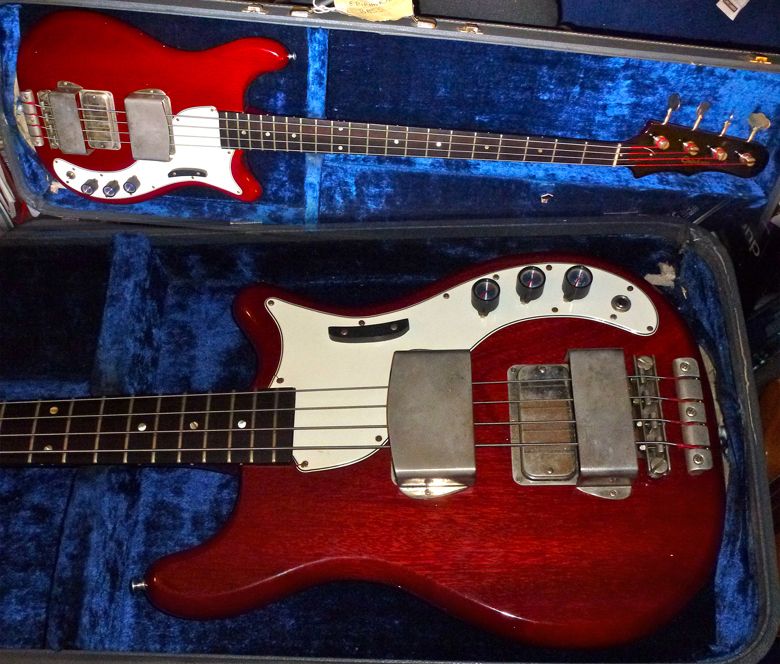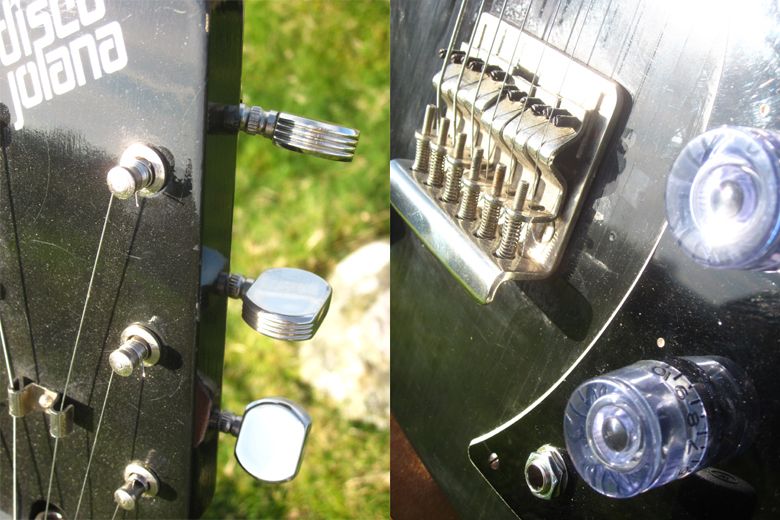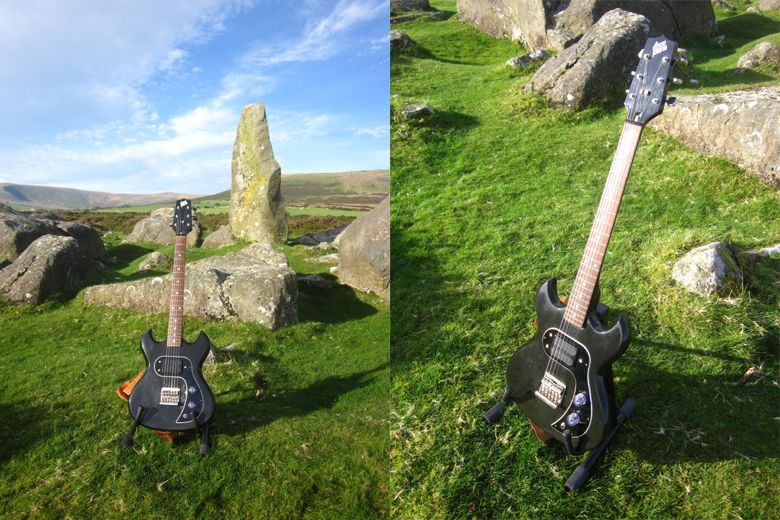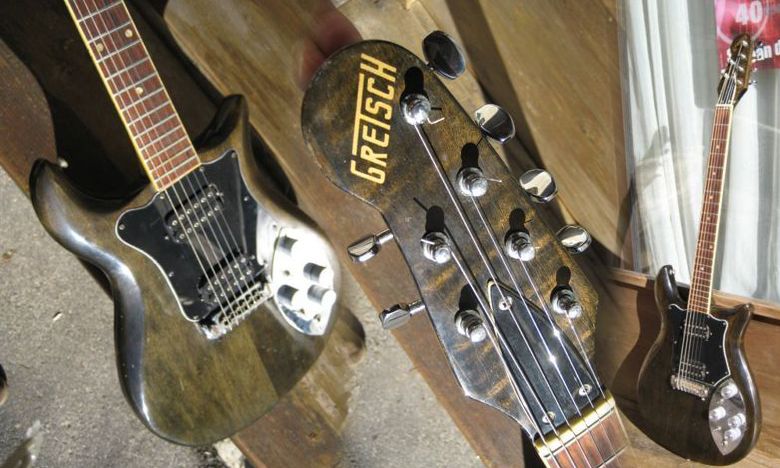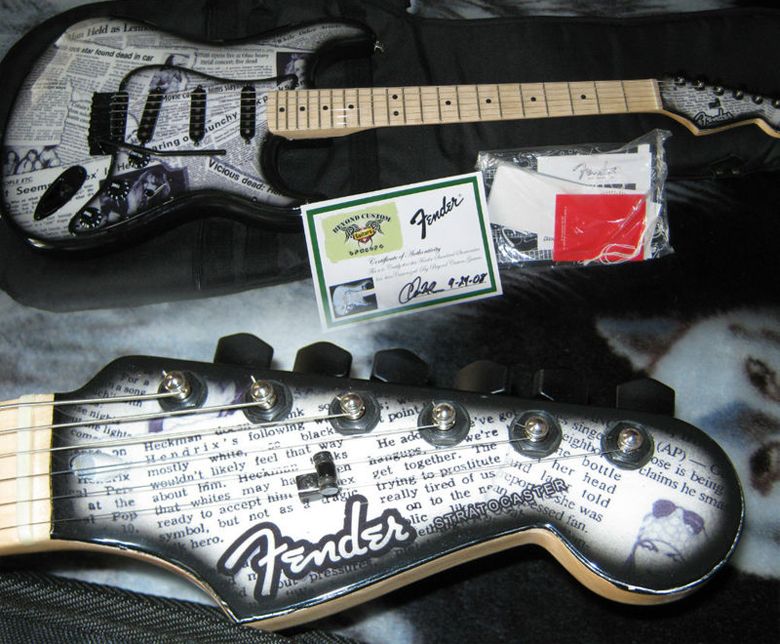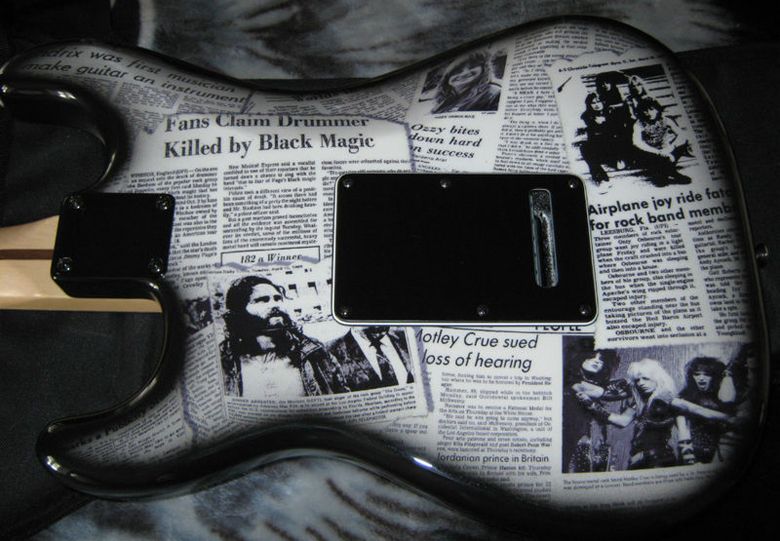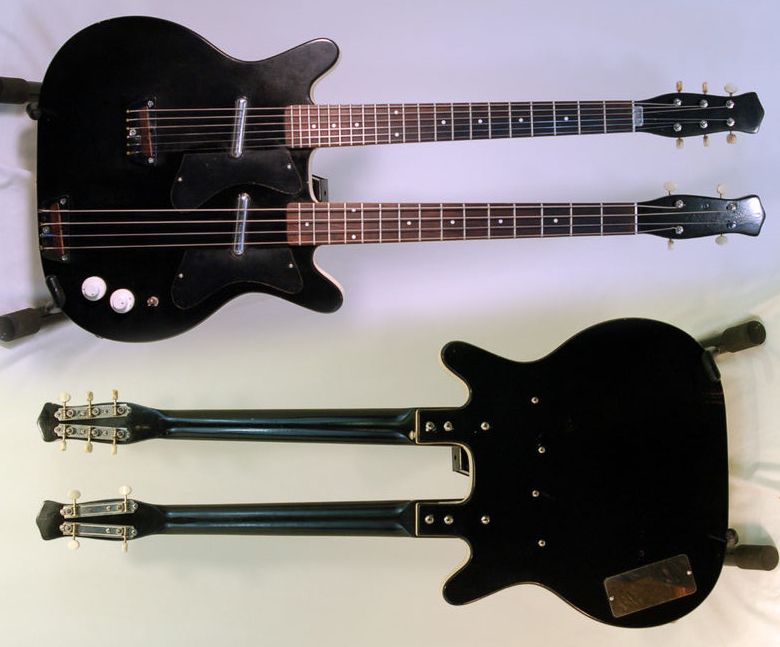guitarz.blogspot.com:
You know that here on Guitarz we are particular fans of guitars from behind the Iron Curtain, and here is another one, a Jolana Neoton electric hollowbody jazz-type guitar in greenburst finish. I have no way of telling how way it plays - or should I say how playable it might be after a proper set-up - but if I had the readies available I would buy this for looks alone because as an object it is a thing of beauty.
I must admit the neck adjustment fills me with dread. When I was a kid, my family used to have an old Russian acoustic with a neck set like this and it was ghastly.
Currrently listed on eBay with a starting price of £169 and with free shipping within the European Union.
G L Wilson
© 2011, Guitarz - The Original Guitar Blog - now in its 10th year!
Wednesday 30 November 2011
Tuesday 29 November 2011
1960s Kawai solidbody electric in Daphne Blue
guitarz.blogspot.com:
Whilst on the whole I am a fan of Japanese guitars, that is not to say that everything with strings produced in Japan was of high quality. Some of the more budget instruments from the 1960s and 1970s were quite shocking. I fear that this 1960s Kawai might well fall into that category. Despite the attractive Fender-esque Daphne Blue finish (or an approximation thereof) it does look remarkably similar to some of the Kay-branded Teiscos that in the UK were stocked by shops such as Woolworths and which were quite gruesome when it came to playability. The seller claims that the guitar has a great action and tone, and that he used to use it in a professional band, so maybe this one was quite a player or maybe that's just eBay selling hype.
The guitar is currently listed on eBay UK with a Buy It Now price of £199.99 which, I think, is four times what it is worth. But who knows? Perhaps it IS an amazing tone machine.
G L Wilson
© 2011, Guitarz - The Original Guitar Blog - now in its 10th year!
Whilst on the whole I am a fan of Japanese guitars, that is not to say that everything with strings produced in Japan was of high quality. Some of the more budget instruments from the 1960s and 1970s were quite shocking. I fear that this 1960s Kawai might well fall into that category. Despite the attractive Fender-esque Daphne Blue finish (or an approximation thereof) it does look remarkably similar to some of the Kay-branded Teiscos that in the UK were stocked by shops such as Woolworths and which were quite gruesome when it came to playability. The seller claims that the guitar has a great action and tone, and that he used to use it in a professional band, so maybe this one was quite a player or maybe that's just eBay selling hype.
The guitar is currently listed on eBay UK with a Buy It Now price of £199.99 which, I think, is four times what it is worth. But who knows? Perhaps it IS an amazing tone machine.
G L Wilson
© 2011, Guitarz - The Original Guitar Blog - now in its 10th year!
1967 Rickenbacker 6000 Bantar Electric 5-String Banjo
guitarz.blogspot.com:
This instrument is unmistakably a Rickenbacker with its gently contoured upper body edges, the back's checkered binding, the varnished rosewood neck with distinctive triangular inlays, the fireglo finish... but it's a banjo!
Indeed it's a Rickenbacker 6000 bantar, a hybrid between a solid electric guiar and a 5-string banjo, as played be legendary banjoist Bela Fleck. It doesn't feature the skin as found on a traditional banjo so is not going to have the same percussive tone, so soundwise its classid Rickenbacker all the way, just utilising banjo stringing and tuning.
Another weird Rickenbacker hybrid instrument of the time was the Banjitar, which according to the promotional literature:
G L Wilson
© 2011, Guitarz - The Original Guitar Blog - now in its 10th year!
This instrument is unmistakably a Rickenbacker with its gently contoured upper body edges, the back's checkered binding, the varnished rosewood neck with distinctive triangular inlays, the fireglo finish... but it's a banjo!
Indeed it's a Rickenbacker 6000 bantar, a hybrid between a solid electric guiar and a 5-string banjo, as played be legendary banjoist Bela Fleck. It doesn't feature the skin as found on a traditional banjo so is not going to have the same percussive tone, so soundwise its classid Rickenbacker all the way, just utilising banjo stringing and tuning.
Another weird Rickenbacker hybrid instrument of the time was the Banjitar, which according to the promotional literature:
"...combines the sounds of the plectrum banjo, mandolin, Hawaiian guitar and Spanish guitar. Two harmony string pairs and two single strings plus a vibrato unit create this incredible range of tones."To look at the Banjitar you might think at first glance that it was a standard Rickenbacker guitar, but the very narrow long neck might cause you to do a double take.
G L Wilson
© 2011, Guitarz - The Original Guitar Blog - now in its 10th year!
Monday 28 November 2011
Rectangular Union Flag "prototype" guitar
guitarz.blogspot.com:
The seller of this one-off, supposedly "prototype" rectangular-shaped guitar tells us that the angled neck makes for quite an ergonomic instrument. I must confess that I remain unconvinced, although without trying it out for myself there's no way of knowing for sure.
It's a pity that the Union Flag has been inaccurately rendered - the red diagonal stripes should be set to one side within the diagonal white stripes with a counter-clockwise bias so as to give a pinwheel effect. Oh well, at least it's better than Gibson's sorry effort.
Currently listed on eBay UK (where else?) with a Buy It Now price of £270.
G L Wilson
© 2011, Guitarz - The Original Guitar Blog - now in its 10th year!
The seller of this one-off, supposedly "prototype" rectangular-shaped guitar tells us that the angled neck makes for quite an ergonomic instrument. I must confess that I remain unconvinced, although without trying it out for myself there's no way of knowing for sure.
It's a pity that the Union Flag has been inaccurately rendered - the red diagonal stripes should be set to one side within the diagonal white stripes with a counter-clockwise bias so as to give a pinwheel effect. Oh well, at least it's better than Gibson's sorry effort.
Currently listed on eBay UK (where else?) with a Buy It Now price of £270.
G L Wilson
© 2011, Guitarz - The Original Guitar Blog - now in its 10th year!
Have you ever seen and heard a Piyanolin?
Let's make a little step aside the strict guitar field to discover and enjoy the Piyanolin, an oud/violin hybrid invented in the Ottoman Empire in the early 20th century (this one is a recent model by Cengiz Sarıkuş) and beautifully played by Gürsel Torun, first as a violin, then as an oud.
Bertram
© 2011, Guitarz - The Original Guitar Blog - now in its 10th year!
Sunday 27 November 2011
1966 Kapa Minsrel - America's take on the Vox Teardrop
guitarz.blogspot.com:
We've looked at several Kapa guitars before, and this particular Vox-like Kapa Minstrel from 1966 is attracting some furious bidding on eBay with just under nine hours left before the close of the auction at the time of writing. Despite the "Made in USA" legend on the headstock, Kapa only built the bodies and asembled the guitars in Hyattsville, Maryland. Necks and hardware came courtesy of Germany's Höfner, or on later examples the hardware was imported from Japan.
G L Wilson
© 2011, Guitarz - The Original Guitar Blog - now in its 10th year!
We've looked at several Kapa guitars before, and this particular Vox-like Kapa Minstrel from 1966 is attracting some furious bidding on eBay with just under nine hours left before the close of the auction at the time of writing. Despite the "Made in USA" legend on the headstock, Kapa only built the bodies and asembled the guitars in Hyattsville, Maryland. Necks and hardware came courtesy of Germany's Höfner, or on later examples the hardware was imported from Japan.
G L Wilson
© 2011, Guitarz - The Original Guitar Blog - now in its 10th year!
Custom 77 Roxy - a new classic?
I know that I probably spend much too much time ranting here about how unimaginative guitar making became in the last decades, so let's cut the crap and rejoice over creative luthiers and small companies that can still produce guitars such as the Custom 77 Roxy, an original yet sober, timeless and classy semi-hollow wonder that has everything it takes to become a new classic.
I love this guitar, firstly for its beautiful bevelled outline, both sensual and dynamic, and the fact that it's a semi-hollow that doesn't have to be a copy of an ES-335 to have credibility. I also appreciate the Duesenberg-style bridge humbucker + neck P90 combination, the simple pickguard, the wraparound bridge, the old-school F-hole on this radical body, and the controls positions seem to be well thought - not just placed where tradition tells... I just wish it was bigger but it's just because I'm big and I'm still looking for my dream semi-hollow guitar!
Custom 77 is an interesting French guitar company that released nice original models, on top of producing the inevitable Fender/Gibson copies (it's probably necessary to generate basic income, but that's the buyers's fault, isn't it?) - all with Iggy/Ramones/Clash inspired names - plus basses and acoustic guitars, also drums and cymbals and they just started an effects boutique line. I will keep an eye on this company because I'm sure that they will keep releasing new cool stuff and one day I will want some of it...
Bertram
© 2011, Guitarz - The Original Guitar Blog - now in its 10th year!
Saturday 26 November 2011
1968 Fender Coronado II semi-hollowbody in southpaw edition and Antigua finish
guitarz.blogspot.com:
Here's another left-handed Fender in Antigua finish, this one being their almost forgotten first attempt at a semi-hollowbody guitar, the Fender Coronado II. The Coronado series was designed by Roger Rossmeisl, who had previously designed guitars for Rickenbacker, and were produced between 1966 and 1972. The Coronado models I and II differed in number of pickups (which, incidentally, were made by DeArmond), the Coronado I having a single neck pickup and the Coronado II having an additional pickup in the bridge position. There was also a 12-string model, the Coronado XII, plus a bass model. Antigua was not the only rare finish, as a number of Coronado II and XIIs were made in Wildwood editions with bodies constructed of highly grained beech wood from trees which had been injected with colourful chemical dyes before being harvested.
But back to the Antigua finish. Note how the 1960s Antigua differs from that produced in the late 1970s. The 60s version is almost a cream to black burst, whereas in the 1970s the whole burst effect is more "mushroom"-like. A few years ago I had one of the Crafted In Japan Fender Strat reissues in Antigua, and the colour was different yet again having more of a green tinge to it.
What's more, the eBay listing tells us that the above-pictured Fender Coronado II originally had a cherry finish before being refinished in the factory in Antigua. I had heard the the Antigua finish was originally developed to hide a mistake and wonder if this might be the reason for this guitar being refinished. (Anyone know the full story?)
Anyway, this guitar is currently being offered for sale on eBay with a Buy It Now price of $2,590.
G L Wilson
Additional: Via the comments Sam writes:
© 2011, Guitarz - The Original Guitar Blog - now in its 10th year!
Here's another left-handed Fender in Antigua finish, this one being their almost forgotten first attempt at a semi-hollowbody guitar, the Fender Coronado II. The Coronado series was designed by Roger Rossmeisl, who had previously designed guitars for Rickenbacker, and were produced between 1966 and 1972. The Coronado models I and II differed in number of pickups (which, incidentally, were made by DeArmond), the Coronado I having a single neck pickup and the Coronado II having an additional pickup in the bridge position. There was also a 12-string model, the Coronado XII, plus a bass model. Antigua was not the only rare finish, as a number of Coronado II and XIIs were made in Wildwood editions with bodies constructed of highly grained beech wood from trees which had been injected with colourful chemical dyes before being harvested.
But back to the Antigua finish. Note how the 1960s Antigua differs from that produced in the late 1970s. The 60s version is almost a cream to black burst, whereas in the 1970s the whole burst effect is more "mushroom"-like. A few years ago I had one of the Crafted In Japan Fender Strat reissues in Antigua, and the colour was different yet again having more of a green tinge to it.
What's more, the eBay listing tells us that the above-pictured Fender Coronado II originally had a cherry finish before being refinished in the factory in Antigua. I had heard the the Antigua finish was originally developed to hide a mistake and wonder if this might be the reason for this guitar being refinished. (Anyone know the full story?)
Anyway, this guitar is currently being offered for sale on eBay with a Buy It Now price of $2,590.
G L Wilson
Additional: Via the comments Sam writes:
I have a book on Fender called The Fender Electric Guitar Book: A Complete History Of Fender Instruments.So yeah, perfectly conceivable - and very likely - that this was one such Coronado originally finished in cherry and then refinshed in Antigua by Fender after the binding failure damaged the previous finish. - GLW
Here's what it says: "Virgilio 'Babe' Simoni remembered a particular problem with the Coronados... 'We couldn't get the binding material to stick to the Coronados,' he said later. 'We'd bind them at night and come back in the morning and the thing would be popped loose. [So we had to] re-bind them several times, and the veneer is very thin on them.' In order to cover up the burn marks caused by this re-binding, the team had no choice but to devise a special white-to-brown shaded finish, which they called Antigua, to salvage the scorched Coronados."
© 2011, Guitarz - The Original Guitar Blog - now in its 10th year!
"Leningrad Hodad" by North of Malibu featuring three Waterstone custom light show guitars
guitarz.blogspot.com:
Thanks to Greg Cadman who posted this video clip on the Guitarz Facebook page.
Interesting guitars, custom-made by Waterstone Guitars they are styled after a Fender Jazzmaster/Jaguar design with reverse headstocks and with a Rickenbacker-style lightshow.
G L Wilson
© 2011, Guitarz - The Original Guitar Blog - now in its 10th year!
Thanks to Greg Cadman who posted this video clip on the Guitarz Facebook page.
Interesting guitars, custom-made by Waterstone Guitars they are styled after a Fender Jazzmaster/Jaguar design with reverse headstocks and with a Rickenbacker-style lightshow.
G L Wilson
© 2011, Guitarz - The Original Guitar Blog - now in its 10th year!
Friday 25 November 2011
Southpaw Fender Precision Bass in Antigua finish
guitarz.blogspot.com:
What's rarer than a late 1970s Fender Precision Bass in Antigua finish? Well, how about a left-handed late 1970s Fender Precision Bass in Antigua finish? The seller actually claims that this example is from 1980 despite the headstock displaying a 1970s serial number (S followed by 6 digits), but it is perfectly possible that this was assembled in 1980 by Fender from parts already in stock from a year or two previously.
This bass is currently listed on eBay with a Buy It Now price of $2,790.
If any of our regular readers are indeed southpaws and would like to join the Guitarz team with a view to writing pieces on the most interesting lefty guitars and basses on eBay and elsewhere, then please do get in touch!
G L Wilson
© 2011, Guitarz - The Original Guitar Blog - now in its 10th year!
What's rarer than a late 1970s Fender Precision Bass in Antigua finish? Well, how about a left-handed late 1970s Fender Precision Bass in Antigua finish? The seller actually claims that this example is from 1980 despite the headstock displaying a 1970s serial number (S followed by 6 digits), but it is perfectly possible that this was assembled in 1980 by Fender from parts already in stock from a year or two previously.
This bass is currently listed on eBay with a Buy It Now price of $2,790.
If any of our regular readers are indeed southpaws and would like to join the Guitarz team with a view to writing pieces on the most interesting lefty guitars and basses on eBay and elsewhere, then please do get in touch!
G L Wilson
© 2011, Guitarz - The Original Guitar Blog - now in its 10th year!
Leroy "Sugarfoot" Bonner plays his trademark Mosrite doubleneck (with the Ohio Players)
And now, let's funk!
Bertram
© 2011, Guitarz - The Original Guitar Blog - now in its 10th year!
guitarz.blogspot.com
Thursday 24 November 2011
Can you identify this fretless bass guitar?
guitarz.blogspot.com:
I have absolutely no idea as to the identity of this small-bodied fretless bass guitar currently listed on eBay UK. It's a weird one for sure with quite a space-age design incorporating a monkey grip in the body, three pickups, and unusual looking hardware. I'd guess that it might be Eastern European, but that really is a shot in the dark. If anyone can give us a more definite idenification, then please let us know via the comments!
Thanks to Alex for bringing this oddity of a bass to my attention.
G L Wilson
© 2011, Guitarz - The Original Guitar Blog - now in its 10th year!
I have absolutely no idea as to the identity of this small-bodied fretless bass guitar currently listed on eBay UK. It's a weird one for sure with quite a space-age design incorporating a monkey grip in the body, three pickups, and unusual looking hardware. I'd guess that it might be Eastern European, but that really is a shot in the dark. If anyone can give us a more definite idenification, then please let us know via the comments!
Thanks to Alex for bringing this oddity of a bass to my attention.
G L Wilson
© 2011, Guitarz - The Original Guitar Blog - now in its 10th year!
Washburn MR-400 Custom
Usually I loathe this kind of paint jobs, the easy and intruding horror comics/graffiti style that reduces everything it touches into pathetic boyish machismo. But I must say that in the case of this Washburn MR-400 it's surprisingly good, with this close-up framing that turns the image into a quasi -abstract pattern - it's unusually intelligent for this kind of things, and gives it an enjoyable second degree.
On top of this, the guitar is quite cool I must say. As far as I understood, the Washburn MR series models are Sammy Hagar signatures - the 400 being the P90s version - and look like thinline wider LPs with strangely shaped and placed soundholes - a very nice touch, mostly combined with the florentine cutaway. The paint job comes from Washburn's custom shop.
I have problems understanding Washburn's policy: it's an old company that has been there for ever and that could claim to belong to the holy ancients, but they seem to keep low profile, for example they don't keep archives of their discontinued models - and they've had prestigious users like Brian May or Roger Waters who even had a signature model (not to mention Paul Stanley, but who can still think that KISS is attractive?) - and don't try to claim a 'cult' status like many of their competitors on the guitar market... They have original though classic designs, also innovative technology, but their catalogue is full of LPs clones and superstrats... I have a good feeling though about their products, but it's a blur impression really not based on how they communicate about themselves!
Bertram
© 2011, Guitarz - The Original Guitar Blog - now in its 10th year!
Wednesday 23 November 2011
Vintage & Rare guitar of the week: Liquid Metal Guitars LMG T WS engraved aluminium Tele
guitarz.blogspot.com:
Here's another highly decorated Telecaster-type guitar, the Liquid Metal Guitars LMG T WS. The W and S in the guitar's name are the initials of Warren Smith, an engraver and master craftsman in metals, based in Armstrong, B.C., who has been working on jewellery pieces for over 20 years and has recently relished the opporunity of working on the larger canvasses offered by LMG's guitar bodies.
This guitar is being sold via Vintage & Rare priced at €2,999. See Vintage & Rare for more details.
G L Wilson
© 2011, Guitarz - The Original Guitar Blog - now in its 10th year!
Here's another highly decorated Telecaster-type guitar, the Liquid Metal Guitars LMG T WS. The W and S in the guitar's name are the initials of Warren Smith, an engraver and master craftsman in metals, based in Armstrong, B.C., who has been working on jewellery pieces for over 20 years and has recently relished the opporunity of working on the larger canvasses offered by LMG's guitar bodies.
This guitar is being sold via Vintage & Rare priced at €2,999. See Vintage & Rare for more details.
G L Wilson
© 2011, Guitarz - The Original Guitar Blog - now in its 10th year!
Fender Japan Floral Print Telecasters - a modern take on the Paisley and Blue Flower designs
guitarz.blogspot.com:
They are probably too flowery for many guitarists' tastes, but I think these new floral print Telecasters from Fender Japan (official designation TL69-SPL) are quite stunning. Perhaps you'd need to wear a Hawaiian shirt (or more appropriately a silk kimono) whilst playing one, or maybe that would be overkill.
Other than the particularly loud finish on, each of the three designs available are based on a pretty standard Tele with basswood body, one-piece maple neck, the usual two Tele pickups, and 3-saddle Telecaster ashtray-style bridge.
Thanks again to Keith McCreary who has obviously been closely scrutinizing the Fender Japan website.
G L Wilson
© 2011, Guitarz - The Original Guitar Blog - now in its 10th year!
They are probably too flowery for many guitarists' tastes, but I think these new floral print Telecasters from Fender Japan (official designation TL69-SPL) are quite stunning. Perhaps you'd need to wear a Hawaiian shirt (or more appropriately a silk kimono) whilst playing one, or maybe that would be overkill.
Other than the particularly loud finish on, each of the three designs available are based on a pretty standard Tele with basswood body, one-piece maple neck, the usual two Tele pickups, and 3-saddle Telecaster ashtray-style bridge.
Thanks again to Keith McCreary who has obviously been closely scrutinizing the Fender Japan website.
G L Wilson
© 2011, Guitarz - The Original Guitar Blog - now in its 10th year!
Tuesday 22 November 2011
Official Fender Japan limited edition Spider Man Mustang guitar
guitarz.blogspot.com:
We've looked at guitars based on comic book superheroes before (e.g. Superman and Batman) but this Spider Man guitar is official Fender product. Issued by Fender Japan, the Fender MG Spider-Man is a Mustang with basswood body, 2 singlecoil pickups with on/off/phase switch settings for each and the now legendary Dynamic Vibrato for which the Mustang is famous. But most obviously it has an in-your-face Spider Man finish which may be a little too pink for the tastes of some sensitive souls. It even has a competition stripe of sorts, a "Spidey" competition stripe, I guess.
If you want one, you'll have to be quick because this is a limited edition of only 50 examples; also it's my understanding that these are being produced for the Japanese market only, so good luck in trying to track one down. (Why is it that Fender Japan always seems to have the most exciting range of Fender guitars?)
Thanks to Keith McCreary for bringing this guitar to our attention.
G L Wilson
© 2011, Guitarz - The Original Guitar Blog - now in its 10th year!
We've looked at guitars based on comic book superheroes before (e.g. Superman and Batman) but this Spider Man guitar is official Fender product. Issued by Fender Japan, the Fender MG Spider-Man is a Mustang with basswood body, 2 singlecoil pickups with on/off/phase switch settings for each and the now legendary Dynamic Vibrato for which the Mustang is famous. But most obviously it has an in-your-face Spider Man finish which may be a little too pink for the tastes of some sensitive souls. It even has a competition stripe of sorts, a "Spidey" competition stripe, I guess.
If you want one, you'll have to be quick because this is a limited edition of only 50 examples; also it's my understanding that these are being produced for the Japanese market only, so good luck in trying to track one down. (Why is it that Fender Japan always seems to have the most exciting range of Fender guitars?)
Thanks to Keith McCreary for bringing this guitar to our attention.
G L Wilson
© 2011, Guitarz - The Original Guitar Blog - now in its 10th year!
Never mind the CBGs here a Marks and Spencers biscuit tin guitar!
guitarz.blogspot.com:
Very much in the style of a cigar box guitar, this three-stringer is a Marks & Spencers Biscuit Tin guitar based on a novelty biscuit tin shaped like a Marks & Spencers delivery van.
This guitar is currently listed on eBay UK with a starting price of £0.99. The seller very honestly comments that: "As you would expect, it ain't a great sound, but it is great fun!"
G L Wilson
© 2011, Guitarz - The Original Guitar Blog - now in its 10th year!
Very much in the style of a cigar box guitar, this three-stringer is a Marks & Spencers Biscuit Tin guitar based on a novelty biscuit tin shaped like a Marks & Spencers delivery van.
This guitar is currently listed on eBay UK with a starting price of £0.99. The seller very honestly comments that: "As you would expect, it ain't a great sound, but it is great fun!"
G L Wilson
© 2011, Guitarz - The Original Guitar Blog - now in its 10th year!
Monday 21 November 2011
A 1980s take on the extravagant Tokai Hummingbird
Unfortunately I couldn't find any information about this Tokai, but you can't deny that it looks to the Tokai Gakki Hummingbird like the Yamaha SC looks to its SGV predecessor: a toned down metal-oriented guitar. Having lost its German carve, contoured pickguard and slanted singlecoil neck pickup, it's a perfect 1980s hair-metal instrument, with violent red finish, one zebra humbucker in bridge position and Floyd Rose trem.
Isn't it a clear denial of the psyche-surf-pop brilliancy of the original Hummingbird? I would have overlooked it if I hadn't kept in mind the subtle finish of the SC-600 I posted about a couple of weeks ago, and how it reveals that even dulled in dull times, these crazy Japanese designs stayed above the lot!
Isn't it a clear denial of the psyche-surf-pop brilliancy of the original Hummingbird? I would have overlooked it if I hadn't kept in mind the subtle finish of the SC-600 I posted about a couple of weeks ago, and how it reveals that even dulled in dull times, these crazy Japanese designs stayed above the lot!
Bertram
© 2011, Guitarz - The Original Guitar Blog - now in its 10th year!
guitarz.blogspot.com
Tokai
Sunday 20 November 2011
Electra Phoenix X-630S bass and matching Electra Phoenix X-140S
guitarz.blogspot.com:
Here's an email from Tyler:
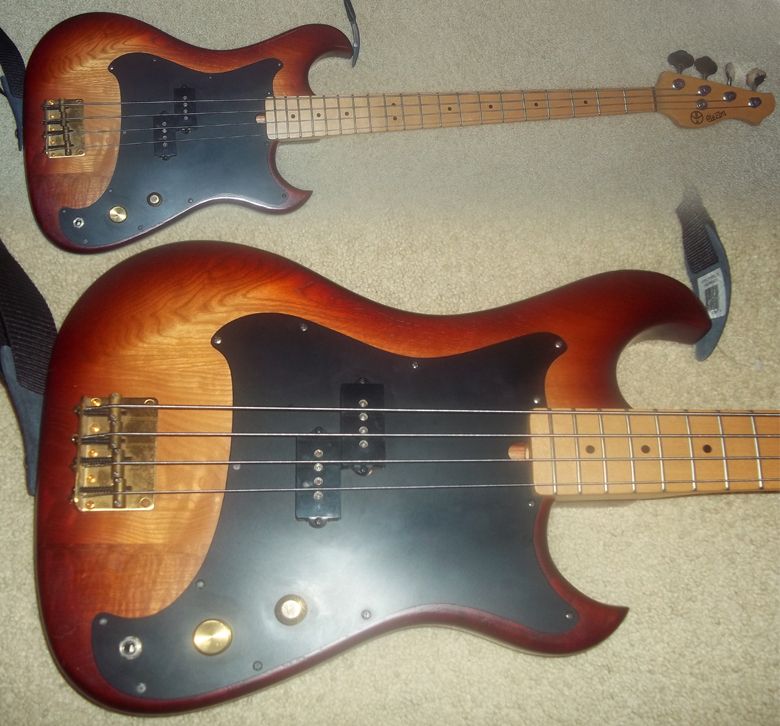 Nice find! While these are not some of more highly desirable Electra guitars and basses with built-in effects modules, the brand is known for its high quality of manufacture and playability. These Japanese-made guitars were probably made by Matsumoko, the design being reminiscent of the Westone brand.
Nice find! While these are not some of more highly desirable Electra guitars and basses with built-in effects modules, the brand is known for its high quality of manufacture and playability. These Japanese-made guitars were probably made by Matsumoko, the design being reminiscent of the Westone brand.
G L Wilson
© 2011, Guitarz - The Original Guitar Blog - now in its 10th year!
Here's an email from Tyler:
Today I've got something kind of special to me. My first serious guitar was my Electra Phoenix X-140S. While perusing eBay yesterday, I saw a matching bass, a Phoenix X-630S. I thought I'd just be dreaming, until I noticed it was at a local shop. There was a bit of a frantic search when the employees couldn't locate it, but eventually it was found.
It's pretty basic, one pickup, volume and tone. Maple neck/fretboard, ash body, brass hardware.
My one complaint is that it is setup with flatwounds. I'll be getting some new strings promptly.
Tyler
 Nice find! While these are not some of more highly desirable Electra guitars and basses with built-in effects modules, the brand is known for its high quality of manufacture and playability. These Japanese-made guitars were probably made by Matsumoko, the design being reminiscent of the Westone brand.
Nice find! While these are not some of more highly desirable Electra guitars and basses with built-in effects modules, the brand is known for its high quality of manufacture and playability. These Japanese-made guitars were probably made by Matsumoko, the design being reminiscent of the Westone brand.G L Wilson
© 2011, Guitarz - The Original Guitar Blog - now in its 10th year!
Duff McKagan Fender P-bass / snowboard hybrid!
guitarz.blogspot.com:
Here's an email from JPM:
G L Wilson
© 2011, Guitarz - The Original Guitar Blog - now in its 10th year!
Here's an email from JPM:
Longtime Guitarz reader, it's an amazing blog.Hey, thanks for that JPM. We've seen a few guitars already made out of pieces of sporting equipment (cricket bat guitar, tennis racquet guitar, even a guitar made from a boat oar) so I guess it figured sooner or later we were going to get a guitar convered into a piece of sporting equipment instead!
Anyways, I don't know if you're aware of this or not but I just saw on YouTube a snowboard company that build a snowboard out of a Duff McKagan Fender P-bass that is both playable and rideable - its pretty crazy. They even have footage of it being ridden accompanied with a sound from the pickups that they hooked up to a wireless rig.
Check it out, I figured you'd appreciate something like this.
G L Wilson
© 2011, Guitarz - The Original Guitar Blog - now in its 10th year!
Saturday 19 November 2011
Unusual one-off 5- and 6-string through-neck doubleneck guitar
guitarz.blogspot.com:
Steve writes:
Also looking at the shape of the 5-string neck's headstock and comparing it to that of the 6-string, I wondered if it had also been a 6-string but part of the head had broken off and thus it was converted. However, the positioning of the rather cheap Japanese Teisco-like pickups on the 5-string side of the guitar so that the 5-strings align to 5-pole pieces with the one on the bass side left unused would imply otherwise - unless it was a later mod.
All in all, it's a very curious guitar and worthy of our attention here on Guitarz.
G L Wilson
© 2011, Guitarz - The Original Guitar Blog - now in its 10th year!
Steve writes:
Hi, I enjoy your Guitarz Blog and recently found this strange item advertised in a local Buy/Sell. I was tempted to buy it, but the $200 asking price and impracticality of such a guitar made me pass. There are probably more than $200 worth of vintage parts on it, though.Impractical it may be, but it would be a real shame to break up a one-off instrument like this for parts. It looks to be hand-made, possibly by a luthier although no-one of great distinction. Note how the short-scale 5-string neck's fretboard position markers echo those on the 6-string neck from the 6th fret upwards. I briefly wondered if the necks may have come from donor instruments with the 5-string neck being shortened and with a headstock grafted on, but of course these are through-necks so that wouldn't really be possible. Perhaps the fingerboards themselves came off other guitars?
Also looking at the shape of the 5-string neck's headstock and comparing it to that of the 6-string, I wondered if it had also been a 6-string but part of the head had broken off and thus it was converted. However, the positioning of the rather cheap Japanese Teisco-like pickups on the 5-string side of the guitar so that the 5-strings align to 5-pole pieces with the one on the bass side left unused would imply otherwise - unless it was a later mod.
All in all, it's a very curious guitar and worthy of our attention here on Guitarz.
G L Wilson
© 2011, Guitarz - The Original Guitar Blog - now in its 10th year!
Thursday 17 November 2011
1960s Italian wonder Meazzi Zodiac
At first sight, this Meazzi Zodiac looked to me like a small body travel guitar à la Eko Short Gun, then I found this picture of Swiss musician Lili Zeller playing the Zodiac (on fetishguitars.com, like usually when one needs info about Italian vintage guitars), and like me you can see that despite its unusual design, it's a well proportionate and well balanced instrument. I'm happy to have found this guitar today, it's exciting and inspiring, for both a musician and a guitar maker, not to mention a collector...
Unfortunately this one lacks its bridge and trem arm, but they should be easily replaceable, mostly if you take the opportunity to install an upgraded model of bridge, after all, what matters is how well it plays! Meazzi guitars had all you can expect from Italian vintage ones: odd designs, unique pickups and trems, strange controls and plenty of chromed plates! Meazzi started in the 1950s with Antonio Wandré Pioli for designer, who released his first instruments as Framez - a Meazzi sub-brand.
Bertram Unfortunately this one lacks its bridge and trem arm, but they should be easily replaceable, mostly if you take the opportunity to install an upgraded model of bridge, after all, what matters is how well it plays! Meazzi guitars had all you can expect from Italian vintage ones: odd designs, unique pickups and trems, strange controls and plenty of chromed plates! Meazzi started in the 1950s with Antonio Wandré Pioli for designer, who released his first instruments as Framez - a Meazzi sub-brand.
© 2011, Guitarz - The Original Guitar Blog - now in its 10th year!
The "It's supposed to be a snake but it looks like something much more unpleasant" Telecaster
guitarz.blogspot.com:
"THIS IS THE ONLY ONE IN THE WORLD!" screams the eBay listing for this very ugly hand-carved guitar.
Some of us would respond that such scarcity could be considered to be something in its favour.
The strange carved object on this guitar, at closer inspection, reveals itself to be a rattlesnake, but unfortunately from further away it does resemble something that comes out of the rear end of a dog. I'm sorry, the last thing I want to do on this blog is to get all scatalogical and severely lower the tone, but with a guitar like this it is very hard to avoid saying something along those lines.
The carving doesn't work for me, because if that is supposed to be a snake, then what is it meant to be sitting on? A severely sawn-up Telecaster?
Nice try - someone probably put a great deal of effort into this creation - but design-wise it just does not work.
Currently being offered for sale on eBay UK with a Buy It Now price of a staggering £999. (Cough, splutter, choke...)
Thanks (if that is the word I'm looking for) to Alan Newton for bringing this guitar to my attention.
G L Wilson
© 2011, Guitarz - The Original Guitar Blog - now in its 10th year!
"THIS IS THE ONLY ONE IN THE WORLD!" screams the eBay listing for this very ugly hand-carved guitar.
Some of us would respond that such scarcity could be considered to be something in its favour.
The strange carved object on this guitar, at closer inspection, reveals itself to be a rattlesnake, but unfortunately from further away it does resemble something that comes out of the rear end of a dog. I'm sorry, the last thing I want to do on this blog is to get all scatalogical and severely lower the tone, but with a guitar like this it is very hard to avoid saying something along those lines.
The carving doesn't work for me, because if that is supposed to be a snake, then what is it meant to be sitting on? A severely sawn-up Telecaster?
Nice try - someone probably put a great deal of effort into this creation - but design-wise it just does not work.
Currently being offered for sale on eBay UK with a Buy It Now price of a staggering £999. (Cough, splutter, choke...)
Thanks (if that is the word I'm looking for) to Alan Newton for bringing this guitar to my attention.
G L Wilson
© 2011, Guitarz - The Original Guitar Blog - now in its 10th year!
Wednesday 16 November 2011
Vintage & Rare Guitar of the Week: John Entwistle's Epiphone Embassy Bass
guitarz.blogspot.com:
This 1964 Epiphone Embassy bass in cherry finish was owned by the late John Entwistle of The Who, and is one of the instruments featured in his book "Bass Culture". The bass is said to be in excellent original condition; it features Thunderbird pickups, and is still in the same condition as when John set it up with Rotosound strings.
You'll notice the design similarities with the Epiphone Newport bass we looked at recently, although with the bridge-biased Thunderbird pickups on the Embassy you could expect a more "rocky" sound.
Having said that, it's highly likely that this bass will be bought as a collector's piece or as an investment, given its provenance. It is currently being offered for sale, via Vintage & Rare, priced at €8000.
G L Wilson
© 2011, Guitarz - The Original Guitar Blog - now in its 10th year!
This 1964 Epiphone Embassy bass in cherry finish was owned by the late John Entwistle of The Who, and is one of the instruments featured in his book "Bass Culture". The bass is said to be in excellent original condition; it features Thunderbird pickups, and is still in the same condition as when John set it up with Rotosound strings.
You'll notice the design similarities with the Epiphone Newport bass we looked at recently, although with the bridge-biased Thunderbird pickups on the Embassy you could expect a more "rocky" sound.
Having said that, it's highly likely that this bass will be bought as a collector's piece or as an investment, given its provenance. It is currently being offered for sale, via Vintage & Rare, priced at €8000.
G L Wilson
© 2011, Guitarz - The Original Guitar Blog - now in its 10th year!
Tuesday 15 November 2011
1980s Soviet-era Czechoslovakian-made Jolana Disco: piece of unplayable junk OR single-pickup wonder?
guitarz.blogspot.com:
Regular readers of Guitarz will know that we have a particular affection for Soviet-era East European and Russian guitars. When I saw this Jolana Disco guitar from 1980s Czechoslovakia listed on eBay UK recently with a Buy It Now price of just £60, I knew I had to buy it; indeed I think I would have been failing in my duty as a Guitarz author if I hadn't.
The Jolana Disco is a very basic model guitar, that much is obvious just from looking at it. It's a no-nonsense, simple electric guitar. Single pickup, volume and tone controls, no trem or any other fancy gubbins. The design, whilst quite clearly derived from the Gibson SG, is squat, pointy and - dare I say - it's a little bit of an ugly duckling. In fact it reminds me of certain Burns guitars, and I mean that as a compliment.
Because it was made in Soviet-era Eastern Europe we do not have here a guitar be-decked with all the same hardware - pickups, tuners, bridge, etc - as found on countless other brands. The Jolana features home-grown hardware which makes it all the more idiosyncratic. The tuners, for example, are huge and, in my estimation, quite attractive. They are hardly the best tuners in the world, but they seem to do the job. The bridge is highly engineered and shaped from pieces of sheet steel, and is fully adjustable; it looks a little unusual when we are so used to seeing the same old bridges everywhere, but it is fully functional and does the job.
The finish is black and THICK. I suspect that it may hide a body of cheap timber - I don't think it's plywood because you normally see the telltale ridges of ply where the finish has sunken in around the sides of the guitar.
The Jolana Disco has just a single pickup, and what a pickup it is! It's a HUGE humbucker and is positioned slap bang in the centre of the guitar's body. To my ears it sounds great and can provide everything from a crystal clear bell-like tone to downright raunchy overdrive. The positioning might throw a few people, and although I'm not usually a fan of tone controls on guitars, in this instance the tone control is essential in making sure you have the required amount of treble.
The volume and tone controls have over-sized chunky clear plastic knobs which I find quite ugly, and which do look rather cheap. The pickguard (or scratchplate) is quite minimalistic and is essentially an over-large pickup surround combined with a control plate.
I've read reviews of this guitar where the owner has commented with words to the effect that it is virtually unplayable. Well, either they had a particularly bad example, or else - as I suspect - they weren't trying hard enough to get on with the guitar and to allow it to shine.
I admit I found it awkward to play at first. The biggest hurdle to overcome is the high radius of the fingerboard. Boy, that fingerboard ain't half got a curve to it! If you prefer your fingerboards flat or virtually flat, you'd be in for a shock with this Jolana. Still it doesn't take too much perseverance to become accustomed to the fingerboard radius, and I feel the results are well worth it because this guitar is quite playable once you get over that initial shock.
The other thing that might freak you out is the position of the pickup, which as I have mentioned already is slap bang in the centre of the body. I hear so many people say, "Oh, I only ever use the bridge pickup," and that is something that never ceases to amaze me. I think this goes back to guitars that have those stupid "Rhythm/Treble" legends on their pickup selector switches (Yeah, Gibson and their imitators!). Put simply, the mental process goes like this: Lead guitar is cool, rhythm is boring. Who wants to be a rhythm guitarist? So this totally erroneous notion that the neck pickup is the rhythm pickup and the bridge pickup is the lead pickup, i.e. the COOL pickup, has been perpetuated. Well, it's complete bullshit. Most guitarists rate Jimi Hendrix, so I say to them check out video footage of Hendrix (the Hendrix at Woodstock DVD is a good one), check out the close ups and tell me what pickup he uses for most of his solos. Yup, you've guessed it, it's the neck pickup. And then tell me that that's NOT lead guitar playing.
So, for a single pickup guitar, I'd argue, the obvious position for a pickup is in the centre. It's neither too trebley nor too bassy. Sure, it's a compromise to some people, but as I've said you can bring the tone control into play. And really, I think that's all you need.
So yeah, I LIKE this little ugly duckling of a guitar. I admit the action could be improved upon, it has a slight tendency to neck heaviness (small body, large headstock) and it does have a few little rattles here and there, but to me these add to the character of the instrument. All in all, it's a highly playable no-nonsense guitar, and I would happily play it in a band situation.
G L Wilson
P.S. The photos in this blog post are my own work, so please do not copy or re-use without asking permission first!
© 2011, Guitarz - The Original Guitar Blog - now in its 10th year!
Regular readers of Guitarz will know that we have a particular affection for Soviet-era East European and Russian guitars. When I saw this Jolana Disco guitar from 1980s Czechoslovakia listed on eBay UK recently with a Buy It Now price of just £60, I knew I had to buy it; indeed I think I would have been failing in my duty as a Guitarz author if I hadn't.
The Jolana Disco is a very basic model guitar, that much is obvious just from looking at it. It's a no-nonsense, simple electric guitar. Single pickup, volume and tone controls, no trem or any other fancy gubbins. The design, whilst quite clearly derived from the Gibson SG, is squat, pointy and - dare I say - it's a little bit of an ugly duckling. In fact it reminds me of certain Burns guitars, and I mean that as a compliment.
Because it was made in Soviet-era Eastern Europe we do not have here a guitar be-decked with all the same hardware - pickups, tuners, bridge, etc - as found on countless other brands. The Jolana features home-grown hardware which makes it all the more idiosyncratic. The tuners, for example, are huge and, in my estimation, quite attractive. They are hardly the best tuners in the world, but they seem to do the job. The bridge is highly engineered and shaped from pieces of sheet steel, and is fully adjustable; it looks a little unusual when we are so used to seeing the same old bridges everywhere, but it is fully functional and does the job.
The finish is black and THICK. I suspect that it may hide a body of cheap timber - I don't think it's plywood because you normally see the telltale ridges of ply where the finish has sunken in around the sides of the guitar.
The Jolana Disco has just a single pickup, and what a pickup it is! It's a HUGE humbucker and is positioned slap bang in the centre of the guitar's body. To my ears it sounds great and can provide everything from a crystal clear bell-like tone to downright raunchy overdrive. The positioning might throw a few people, and although I'm not usually a fan of tone controls on guitars, in this instance the tone control is essential in making sure you have the required amount of treble.
The volume and tone controls have over-sized chunky clear plastic knobs which I find quite ugly, and which do look rather cheap. The pickguard (or scratchplate) is quite minimalistic and is essentially an over-large pickup surround combined with a control plate.
I've read reviews of this guitar where the owner has commented with words to the effect that it is virtually unplayable. Well, either they had a particularly bad example, or else - as I suspect - they weren't trying hard enough to get on with the guitar and to allow it to shine.
I admit I found it awkward to play at first. The biggest hurdle to overcome is the high radius of the fingerboard. Boy, that fingerboard ain't half got a curve to it! If you prefer your fingerboards flat or virtually flat, you'd be in for a shock with this Jolana. Still it doesn't take too much perseverance to become accustomed to the fingerboard radius, and I feel the results are well worth it because this guitar is quite playable once you get over that initial shock.
The other thing that might freak you out is the position of the pickup, which as I have mentioned already is slap bang in the centre of the body. I hear so many people say, "Oh, I only ever use the bridge pickup," and that is something that never ceases to amaze me. I think this goes back to guitars that have those stupid "Rhythm/Treble" legends on their pickup selector switches (Yeah, Gibson and their imitators!). Put simply, the mental process goes like this: Lead guitar is cool, rhythm is boring. Who wants to be a rhythm guitarist? So this totally erroneous notion that the neck pickup is the rhythm pickup and the bridge pickup is the lead pickup, i.e. the COOL pickup, has been perpetuated. Well, it's complete bullshit. Most guitarists rate Jimi Hendrix, so I say to them check out video footage of Hendrix (the Hendrix at Woodstock DVD is a good one), check out the close ups and tell me what pickup he uses for most of his solos. Yup, you've guessed it, it's the neck pickup. And then tell me that that's NOT lead guitar playing.
So, for a single pickup guitar, I'd argue, the obvious position for a pickup is in the centre. It's neither too trebley nor too bassy. Sure, it's a compromise to some people, but as I've said you can bring the tone control into play. And really, I think that's all you need.
So yeah, I LIKE this little ugly duckling of a guitar. I admit the action could be improved upon, it has a slight tendency to neck heaviness (small body, large headstock) and it does have a few little rattles here and there, but to me these add to the character of the instrument. All in all, it's a highly playable no-nonsense guitar, and I would happily play it in a band situation.
G L Wilson
P.S. The photos in this blog post are my own work, so please do not copy or re-use without asking permission first!
© 2011, Guitarz - The Original Guitar Blog - now in its 10th year!
All of us are looking at the stars
guitarz.blogspot.com:
A Migma Star 61 to be exact. Maybe. It's hard to tell really as every search I've made has revealed a whole range of different Migma guitars claiming to be Star 61s. This one doesn't have the typical Migma tailpiece either. Anyway...
We've all heard or used the expression "a Mickey Mouse guitar", I'm sure. Well, for this seller, his Migma Star 61 has always been his Kater Karlo guitar because it looks like a cartoon (Kater Karlo is the Disney character - Pete - sometime villain and general tough guy). He says the model is rare and, if the paucity of Google searches is anything to go by, he's right. It has a large, thick body, of which he says, "What is the material of the body - no idea, it looks as if he had joined like two halves of bread. Maybe it's made of fiberglass, is certainly very hard. It has a slight Flitteroptik (glitter effect, I guess). You can see on the photos that all the edges of the body are rounded off.
"Contrary to expectations, the guitar is very playable, the pickup works, although only one of the pots seems to function".
The guitar has its own design quirks such as the chunky pickup and the rather haphazard placing of the control panel but it's undoubtedly a Star guitar.
A little research indicates that these were probably not fibre glass but carved wood. There is a seam showing but the joint looks pretty accurate and there's no strip to hide the join like with a Res-O-Glas guitar. Someone once showed me how make a very tight fitting guitar case by making a box to size and then splitting it with a bandsaw lengthways to leave two perfect fitting halves. Maybe this uses a similar approach.
A little more research on http://www.schlaggitarren.de/home.php?text=hersteller&kenn=87%20mfg reveals that "Lothar Junghänel is the inventor of the extravagant "Star Series". They were designed by him and built in Zwickau, and later manufactured under license by Migma.
He celebrated his 82nd birthday on 20/05/2011. His son Hanno Junghänel contacted schlaggitarren and soon they will publish a detailed article on the history of Star & Starlet instruments, and its inventor."
Schlaggitarren also have some nice photos of other Star models and their designer plus a lot of other interesting guitars, so it's well worth checking out.
David in dull and dismal Barcelona Brrrrrrr! Anyone got a brolley?
© 2011, Guitarz - The Original Guitar Blog - now in its 10th year!
Monday 14 November 2011
Gretsch Corvette Deluxe solidbody from 1976
guitarz.blogspot.com:
I've commented before that I particularly like some of Gretsch's solidbody designs, whereas of course that company is mainly known for its hollowbodies. This Gretsch Corvette Deluxe from 1976 is one such example of a solidbody that appeals to me so, from the all-access neck, the sculpted contoured body, the metal control panel, right up to the unusual 2+4 headstock design. It may not be a model coveted or even held in regard by Gretsch fanatics, but it's not one that I would overlook.
Alas, the eBay France auction has finished already, although seeing as it didn't sell with a starting price of €700, maybe it'll be re-listed.
G L Wilson
© 2011, Guitarz - The Original Guitar Blog - now in its 10th year!
I've commented before that I particularly like some of Gretsch's solidbody designs, whereas of course that company is mainly known for its hollowbodies. This Gretsch Corvette Deluxe from 1976 is one such example of a solidbody that appeals to me so, from the all-access neck, the sculpted contoured body, the metal control panel, right up to the unusual 2+4 headstock design. It may not be a model coveted or even held in regard by Gretsch fanatics, but it's not one that I would overlook.
Alas, the eBay France auction has finished already, although seeing as it didn't sell with a starting price of €700, maybe it'll be re-listed.
G L Wilson
© 2011, Guitarz - The Original Guitar Blog - now in its 10th year!
Sunday 13 November 2011
2010 Kay Thin Twin Reissue and other stuff
A certain taste for vintage guitars that may transpire in my posts on Guitarz is in no way a nostalgia for a lost golden age, nor a cult of the origins (who could seriously believe that by some miracle the (almost) first three solid body electric guitar models ever conceived and produced in the 1950s by different companies are perfect and unsurpassed since?) It's just that at some point there've been a global explosion of creativity in guitar making following the invention of the instrument and of the music that fit with it, and there is a lot to learn from it.
You had the same happening in the 1910s, within a few years art and history changed radically due to creative emulation of artists all over the world, and one century later people are still trying to digest, explore and expand the potential of the historical avant-gardes: cubism, futurism, constructivism, dada, fauvism, neoplasticism, etc... Same in music with the 1960s British invasion or the late 1980s rise of electronic music.
And something happens in every domain and all the time, you have people who create things, and then you have people who bank on them - these things require different skills and spirits, so it's rarely the same people. You have also times for creativity and then you have times for making money - we're living such times when it comes to guitars... Imagine that in computers: people would buy huge slow square grey IBM PCs because they're so cool, and that's how Don Estridge invented them back in the day!
Anyway, let's go back to vintage guitars: there are roughly four things you can do with vintage guitars: you can preciously collect old instruments, hoping to get one in mint condition but a beaten one is also cool, and worship them while they gain more value year after year and end up keeping them in a safe. You can copy classic models again and again because, you know, that's the way Leo and Les did them and there's nothing more to do - and it sales -, and saturate the market until people cannot even imagine anymore that there are other guitars out there. You can re-issue vintage creative models so you can benefit from the vintage trend while diversifying and rejuvenating the offer, and as wrote 18th century French poet Antoine Houdard de la Motte: "l'ennui naquit un jour de l'uniformité (boredom was born from uniformity)" (now find other guitar blogs quoting 18th century French poets!). Or you can study the great guitars from the past, get inspired by their audacity with the distance given by time, and create the guitars of the 21st century!
You had the same happening in the 1910s, within a few years art and history changed radically due to creative emulation of artists all over the world, and one century later people are still trying to digest, explore and expand the potential of the historical avant-gardes: cubism, futurism, constructivism, dada, fauvism, neoplasticism, etc... Same in music with the 1960s British invasion or the late 1980s rise of electronic music.
And something happens in every domain and all the time, you have people who create things, and then you have people who bank on them - these things require different skills and spirits, so it's rarely the same people. You have also times for creativity and then you have times for making money - we're living such times when it comes to guitars... Imagine that in computers: people would buy huge slow square grey IBM PCs because they're so cool, and that's how Don Estridge invented them back in the day!
Anyway, let's go back to vintage guitars: there are roughly four things you can do with vintage guitars: you can preciously collect old instruments, hoping to get one in mint condition but a beaten one is also cool, and worship them while they gain more value year after year and end up keeping them in a safe. You can copy classic models again and again because, you know, that's the way Leo and Les did them and there's nothing more to do - and it sales -, and saturate the market until people cannot even imagine anymore that there are other guitars out there. You can re-issue vintage creative models so you can benefit from the vintage trend while diversifying and rejuvenating the offer, and as wrote 18th century French poet Antoine Houdard de la Motte: "l'ennui naquit un jour de l'uniformité (boredom was born from uniformity)" (now find other guitar blogs quoting 18th century French poets!). Or you can study the great guitars from the past, get inspired by their audacity with the distance given by time, and create the guitars of the 21st century!
The re-issue is a good starting point, and it's happening more and more since Eastwood started the trend in 2001. Now you can find Eko's lovely guitars new and functional, and reissued 1952 Kay Thin Twins. This is not the original Kay company that provided so many budget guitars to American players between the 1930s and the 1970s (remember that Kay claimed to have produced the first electric guitars, using pickups several years before Gibson - historians must work on that!), but it's not like we're talking about high-end handmade guitars made by master luthiers in an hidden Shaolin temple. The Thin Twin got its name from its thin blade pickups sticking right out of its hollow-body. It's the kind of instrument on which blues became rock'n'roll out of the spot-lights...
© 2011, Guitarz - The Original Guitar Blog - now in its 10th year!
The Legentary Punk Guitar Of Alex K.
Well this guitar is for sale on eBay and all there is is this:
The Legentary Punk Guitar Of Alex K.That's simple - that's enough. After the 11 cool guitars we saw yesterday, a little bit of crap won't hurt!
Bertram
© 2011, Guitarz - The Original Guitar Blog - now in its 10th year!
Saturday 12 November 2011
Ovation Eclipse 1235-5 semi-hollow wonder
This excessively cool ES-335 style Ovation Eclipse has an interesting story (it it's a true one). It belongs to the late 1960s Storms series - the Tornado model being the most famous of them - whose bodies were actually made by Höfner in Germany. It seems that once they received a batch of bodies with painting problems, but all they had to refinish them was the Lyrachord they used to mold the round bodies of their acoustic guitars (I have this finish on my Breadwinner, it's great!)
That was a good starting point, add to this Höfner 513B blade pickups, classy chrome hardware, a bizarre pickguard and you have this dream guitar, that doesn't look like a 40-year vintage grandma but something Ellen Ripley could have used to smash a Xenomorph with. This guitar was a very short series, like just a few hundred items around 1970, and if there was fairness in this universe, one of them would be mine...
Bertram
© 2011, Guitarz - The Original Guitar Blog - now in its 10th year!
Friday 11 November 2011
11 on 11/11/11: #11 - The Dead Rock Stars Fender Stratocaster
OK, it's the 11th November 2011, that is 11/11/11, and as such today has been designated Nigel Tufnel Day. To celebrate this day of Maximum Elevenness, we here at Guitarz - for this day only - will be posting an unprecedented ELEVEN blog posts! And now, here it is, our ELEVENTH post on 11/11/11:
Do I need to say much about this Mexican-made Fender Stratocaster as refinished by Beyond Custom Guitars? The "newspaper" finish is quite striking, but if you read the headlines and the stories themselves most of them are about the deaths of famous rock stars: John Lennon, Jimi Hendrix, Bon Scott, Sid Vicious, Dimebag Darrell, Kurt Cobain, etc.
Cool or tasteless? You decide.
We hope you have all enjoyed our mammoth 11 guitar blog postings today on Nigel Tufnel Day. I just want to end on a more serious note and point out that in the United Kingdom the 11th day of the 11th month is Remembrance Day when we remember those who died in the two World Wars and that absolutely no disrespect is meant in our blog posts today.
G L Wilson
© 2011, Guitarz - The Original Guitar Blog - now in its 10th year!
Do I need to say much about this Mexican-made Fender Stratocaster as refinished by Beyond Custom Guitars? The "newspaper" finish is quite striking, but if you read the headlines and the stories themselves most of them are about the deaths of famous rock stars: John Lennon, Jimi Hendrix, Bon Scott, Sid Vicious, Dimebag Darrell, Kurt Cobain, etc.
Cool or tasteless? You decide.
We hope you have all enjoyed our mammoth 11 guitar blog postings today on Nigel Tufnel Day. I just want to end on a more serious note and point out that in the United Kingdom the 11th day of the 11th month is Remembrance Day when we remember those who died in the two World Wars and that absolutely no disrespect is meant in our blog posts today.
G L Wilson
© 2011, Guitarz - The Original Guitar Blog - now in its 10th year!
11 on 11/11/11: #10 - Guild T-50 thinline semi-hollowbody from 1982
OK, it's the 11th November 2011, that is 11/11/11, and as such today has been designated Nigel Tufnel Day. To celebrate this day of Maximum Elevenness, we here at Guitarz - for this day only - will be posting an unprecedented ELEVEN blog posts! So, keep tuned throughout the day for eleven weird and wonderful guitars!
This Guild T-50 from 1982 is an absolutely beautiful guitar. It's a semi-hollowbody, thinline, non-cutaway design with timeless classic lines, an almost Art Deco-style pickguard, twin humbuckers and a gorgeous cherry red finish.
The non-cutaway body does seem a little at odds with the date of this guitar, seeing that the 1980s were known for hair metal bands and the rise of the Superstrat and pointy pointy "careful you don't impale yourself" guitars.
This guitar is currently listed on eBay with a Buy It Now price of $1490.
Thanks to Jeffrey Jones for bringing this guitar to our attention.
G L Wilson
© 2011, Guitarz - The Original Guitar Blog - now in its 10th year!
This Guild T-50 from 1982 is an absolutely beautiful guitar. It's a semi-hollowbody, thinline, non-cutaway design with timeless classic lines, an almost Art Deco-style pickguard, twin humbuckers and a gorgeous cherry red finish.
The non-cutaway body does seem a little at odds with the date of this guitar, seeing that the 1980s were known for hair metal bands and the rise of the Superstrat and pointy pointy "careful you don't impale yourself" guitars.
This guitar is currently listed on eBay with a Buy It Now price of $1490.
Thanks to Jeffrey Jones for bringing this guitar to our attention.
G L Wilson
© 2011, Guitarz - The Original Guitar Blog - now in its 10th year!
11 on 11/11/11: #9 - Rickenbacker 650 Sierra with walnut wood body
OK, it's the 11th November 2011, that is 11/11/11, and as such today has been designated Nigel Tufnel Day. To celebrate this day of Maximum Elevenness, we here at Guitarz - for this day only - will be posting an unprecedented ELEVEN blog posts! So, keep tuned throughout the day for eleven weird and wonderful guitars!
Bertram
© 2011, Guitarz - The Original Guitar Blog - now in its 10th year!
Whoever loves pure design and natural wood can only fall for this über-sexy Rickenbacker 650 Sierra with its oiled walnut body and gold-plated hardware. I'm never bored with contemplating the 'cresting wave' of its upper horn (I'm the 25-year lover of a 620!), an acme in woodcraft!
And I love to see this guitar worn, because with its elegance, the beautiful wood and all that gold, it could easily pass for a precious work of art to be kept in a window, and this one has been obviously extensively played on stage. For those who think that an artificially worn guitar has any value, look at the real thing!
Bertram
© 2011, Guitarz - The Original Guitar Blog - now in its 10th year!
11 on 11/11/11: #8 - 1987 Kramer Nightswan
OK, it's the 11th November 2011, that is 11/11/11, and as such today has been designated Nigel Tufnel Day. To celebrate this day of Maximum Elevenness, we here at Guitarz - for this day only - will be posting an unprecedented ELEVEN blog posts! So, keep tuned throughout the day for eleven weird and wonderful guitars!
Here's a guitar that I'm sure Nigel Tufnel would enjoy rocking out on. For many a Kramer collector the Kramer Nightswan is considered the Holy Grail. Quite why, it's hard for a non-Kramer collector to tell, but I'm told that these guitars are amazing players. On first impressions it's just another Superstrat, but you'll notice that the two humbuckers have a treble bias being positioned in the middle and at the bridge. The lower cutaway is also extended so that access to the top frets on the 24-fret neck is unhindered. Also in its favour is that it is a genuine Made in the USA guitar, and hasn't just been thrown together in the Far East.
It is what it is. A no-nonsense guitar built to widdle.
This particular example is located in France and is currently listed on eBay with a Buy It Now price of €1690.
G L Wilson
© 2011, Guitarz - The Original Guitar Blog - now in its 10th year!
Here's a guitar that I'm sure Nigel Tufnel would enjoy rocking out on. For many a Kramer collector the Kramer Nightswan is considered the Holy Grail. Quite why, it's hard for a non-Kramer collector to tell, but I'm told that these guitars are amazing players. On first impressions it's just another Superstrat, but you'll notice that the two humbuckers have a treble bias being positioned in the middle and at the bridge. The lower cutaway is also extended so that access to the top frets on the 24-fret neck is unhindered. Also in its favour is that it is a genuine Made in the USA guitar, and hasn't just been thrown together in the Far East.
It is what it is. A no-nonsense guitar built to widdle.
This particular example is located in France and is currently listed on eBay with a Buy It Now price of €1690.
G L Wilson
© 2011, Guitarz - The Original Guitar Blog - now in its 10th year!
11 on 11/11/11: #7 - 1960s Japanese Electra 2228 semi-hollowbody
OK, it's the 11th November 2011, that is 11/11/11, and as such today has been designated Nigel Tufnel Day. To celebrate this day of Maximum Elevenness, we here at Guitarz - for this day only - will be posting an unprecedented ELEVEN blog posts! So, keep tuned throughout the day for eleven weird and wonderful guitars!
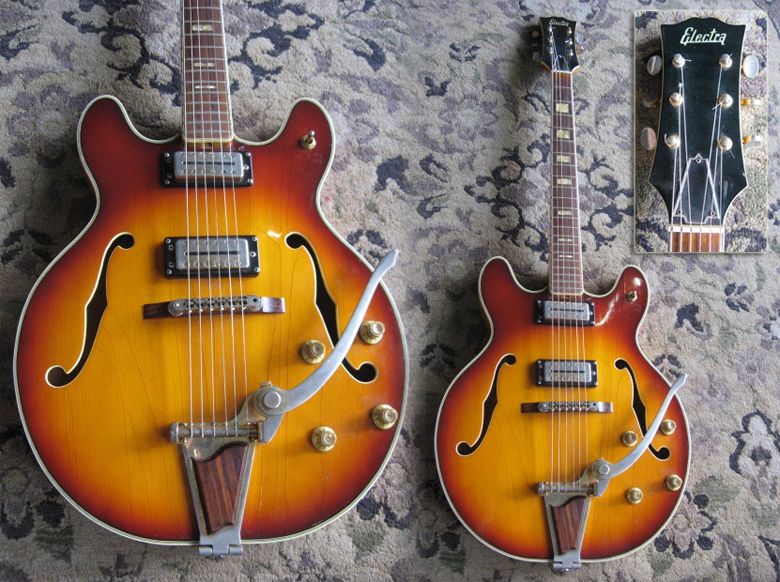
I have a soft spot for semi-hollowbodies and I have a soft spot for vintage Japanese guitars, so this 1960 Electra 2228 ticks both those boxes. It is equipped with a brandless Bigsby-a-like vibrato; it's nice to see that still in place on an old Japanese guitar of this age. I like the way that the finish has crazed with age, which makes the guitar seem all the more venerable somehow. I can imagine it might sound a little bit boxy, maybe a bit rattley, but that does not stop the appeal for me.
G L Wilson
© 2011, Guitarz - The Original Guitar Blog - now in its 10th year!

I have a soft spot for semi-hollowbodies and I have a soft spot for vintage Japanese guitars, so this 1960 Electra 2228 ticks both those boxes. It is equipped with a brandless Bigsby-a-like vibrato; it's nice to see that still in place on an old Japanese guitar of this age. I like the way that the finish has crazed with age, which makes the guitar seem all the more venerable somehow. I can imagine it might sound a little bit boxy, maybe a bit rattley, but that does not stop the appeal for me.
G L Wilson
© 2011, Guitarz - The Original Guitar Blog - now in its 10th year!
11 on 11/11/11: #6 - Vintage Danelectro doubleneck guitar and bass
OK, it's the 11th November 2011, that is 11/11/11, and as such today has been designated Nigel Tufnel Day. To celebrate this day of Maximum Elevenness, we here at Guitarz - for this day only - will be posting an unprecedented ELEVEN blog posts! So, keep tuned throughout the day for eleven weird and wonderful guitars!
Danelectro guitars should be familiar enough to all Guitarz readers. The most famous models are known not only for their very cheap construction methods (the bodies consisted of a simple pine frame with the front and back being made from Masonite) but also, conversely, for the great sounds they made.
This Danelectro guitar and bass doubleneck circa 1961 is a particularly nice example despite the obvious black refinish. In fact I'd go as far to say that the black refinish adds to the road-worn character and vintage vibe of the guitar. Notice how the bass neck is identical in length to the guitar neck, but how the bass bridge is set as far back as the body will allow so as to adhere to the usual short-scale bass length of 30".
This item is located in West Des Moines, Iowa, and currently listed on ebay with a Buy It Now price of $1,599.88.
G L Wilson
© 2011, Guitarz - The Original Guitar Blog - now in its 10th year!
Danelectro guitars should be familiar enough to all Guitarz readers. The most famous models are known not only for their very cheap construction methods (the bodies consisted of a simple pine frame with the front and back being made from Masonite) but also, conversely, for the great sounds they made.
This Danelectro guitar and bass doubleneck circa 1961 is a particularly nice example despite the obvious black refinish. In fact I'd go as far to say that the black refinish adds to the road-worn character and vintage vibe of the guitar. Notice how the bass neck is identical in length to the guitar neck, but how the bass bridge is set as far back as the body will allow so as to adhere to the usual short-scale bass length of 30".
This item is located in West Des Moines, Iowa, and currently listed on ebay with a Buy It Now price of $1,599.88.
G L Wilson
© 2011, Guitarz - The Original Guitar Blog - now in its 10th year!
11 on 11/11/11: #5 - Gibson SB300 cheapo bass
OK, it's the 11th November 2011, that is 11/11/11, and as such today has been designated Nigel Tufnel Day. To celebrate this day of Maximum Elevenness, we here at Guitarz - for this day only - will be posting an unprecedented ELEVEN blog posts! So, keep tuned throughout the day for eleven weird and wonderful guitars!
Bertram
© 2011, Guitarz - The Original Guitar Blog - now in its 10th year!
You know already the Gibson SG200, the early 1970s budget version of the SG - well worse than budget, a big flaw in Gibson's production from a bad phase era. Here is its bass equivalent, the SB300. I don't have more to say about it, but I see more and more of these guitars showing up on eBay and sellers starting to ask vintage prices for them, so I thought I should repost the comment that our reader Teh Gav posted about the SG200:
"I've played dozens of these crude, downmarket '70s SGs over the years, hoping to find one that had potential. I found nothing but sadness and humility. They are bad guitars.I won't deny that there is a certain wild beauty in this bass's crudeness, but guitars are still meant to be usable for music playing, aren't they?
I say this as a huge fan of Melody Makers and pre-Japanese Epiphone solidbodies. It's not a snob thing. It's like, "Oh my God, this guitar feels like it's nailed together from leftover firewood and finished with slapped-on shellac. Uh, let's see how it sounds..."
That is where the sadness generally comes in. The humility has come from watching the numbers on the price tags rise from the moderate three-figures and move steadily toward a thousand dollars. Someone is buying these things, and it makes me feel like a cranky old guy who can't stop himself from wagging an index finger and telling 'back in my day' stories.
Because see here, back in my day, if you needed a guitar and were stuck with a hundred and fifty bucks in your pocket, you would step straight on top of one of those suck-Gibsons whilst making a straight path through the music store to the wall where the used Cort, Fernandez, Hagstrom, and/or Aria Pro II guitars were hanging.
These had no cachet or 'mojo' at all, but for God's sake, at least they freaking worked properly -- and at least they didn't make you feel shallow and vaguely dirty for playing a guitar purely because of the name painted on the headstock.
Seriously, these guitars suck. They have caused many people to experience pain and confusion. Not worth it -- really."
Bertram
© 2011, Guitarz - The Original Guitar Blog - now in its 10th year!
Subscribe to:
Posts (Atom)

